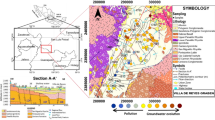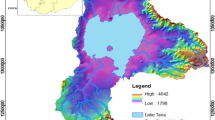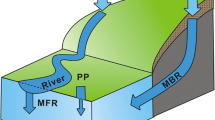Abstract
This study was conducted to identify the origin, hydrogeochemical processes and evolution of groundwater in a tectonic valley. This study was carried out with the aim of quantifying the proportions of groundwater flows contributing to the water chemistry abstracted in a zone of convergence favored by the presence of active faults. The study area is located in the Trans-Mexican Volcanic Belt. End members methodology was applied to identify the mixing of hydrothermal with fresh groundwater, where changes in the aquifer geology result in distinct groundwater chemical signatures. Ternary mixing was quantified using conservative elements. Moreover, other evolutionary processes, such as ion exchange and silicate weathering occur due to changes in the geology of the area. In ternary mixing, each of the end members is associated with the lithology through which it circulates. The local flow contributes 70% of the water to the system, the intermediate flow contributes 14%, and the regional flow contributes 16%. Three types of water are produced: Na-HCO3, due to the interaction of water with volcanic rocks of rhyolitic composition, Na-Mg-HCO3, due to the interaction of water with volcanic rocks of basaltic-andesite composition, and Ca-HCO3, due to the interaction of water with sedimentary calcareous rocks.
Similar content being viewed by others
References Cited
Alaniz-Álvarez, S. A., Nieto-Samaniego, A., Reyes-Zaragoza, M. A., et al., 2001. Estratigrafía y Deformación Extensional en la Región San Miguel Allende-Querétaro. México. Rev. Mexicana de Ciencias Geológicas, 18(2): 129–148 (in Spanish)
American Public Health Association, AWWA (American Water Works Association), Water Environment Federation), 2005. Standard Methods for the Examination of Water and Wastewater, Amer. Public Health Assn., 21: 258–259
Aranda-Gómez, J. J., Levresse, G., Acheco Martínez, J., et al., 2013. Active Sinking at the Bottom of the Rincón de Parangueo Maar (Guanajuato, México) and Its Probable Relation with Subsidence Faults at Salamanca and Celaya. Boletín de la Sociedad Geológica Mexicana, 65(1): 169–188. https://doi.org/10.18268/bsgm2013v65n1a13
Barbieri, M., Nigro, A., Petitta, M., 2017. Groundwater Mixing in the Discharge Area of San Vittorino Plain (Central Italy): Geochemical Characterization and Implication for Drinking Uses. Environmental Earth Sciences, 76(11): 393. https://doi.org/10.1007/s12665-017-6719-1
Carrera, M. L., Higgins, R. W., Kousky, V. E., 2004. Downstream Weather Impacts Associated with Atmospheric Blocking over the Northeast Pacific. Journal of Climate, 17: 4823–4839. https://doi.org/10.1175/jcli-3237.1
Carranco-Lozada, S. E., Ramos-Leal, J. A., Noyola-Medrano, C., et al., 2013. Effects of Change of Use of Land on an Aquifer in a Tectonically Active Region. Natural Science, 05(2): 259–267. https://doi.org/10.4236/ns.2013.52a038
Carrasco-Núñez, G., Milány, M. C., Verma, S. P., 1989. Geology of the Zamorano Volcano, State of Querétaro. Mexican Journal of Geological Sciences, 8(2): 194–201
CEAG, 2000. Follow-up of the Hydrogeological Study and Mathematical Model of the Aquifer of the Irapuato Valley-Valle de Santiago-Huanimaro, Gto. Technical Report, State Water Commission of Guanajuato, Guanajuato. 72
Chae, G. T., Yun, S. T., Kim, K., et al., 2006. Hydrogeochemistry of Sodium-Bicarbonate Type Bedrock Groundwater in the Pocheon Spa Area, South Korea: Water-Rock Interaction and Hydrologic Mixing. Journal of Hydrology, 321(1/2/3/4): 326–343. https://doi.org/10.1016/j.jhydrol.2005.08.006
Cook, P. G., 2003. A Guide to Regional Groundwater Flow in Fractured Rock Aquifers. CSIRO Land and Water, Glen Osmond. 151
Douglas, M., Clark, I. D., Raven, K., et al., 2000. Groundwater Mixing Dynamics at a Canadian Shield Mine. Journal of Hydrology, 235(1/2): 88–103. https://doi.org/10.1016/s0022-1694(00)00265-1
Han, D. M., Liang, X., Jin, M. G., et al., 2010. Evaluation of Groundwater Hydrochemical Characteristics and Mixing Behavior in the Daying and Qicun Geothermal Systems, Xinzhou Basin. Journal of Volcanology and Geothermal Research, 189(1/2): 92–104. https://doi.org/10.1016/j.jvolgeores.2009.10.011
Huizar-Álvarez, R., Mitre-Salazar L. M., Marín-Córdova, S., et al., 2011. Subsidence in Celaya, Guanajuato, Central Mexico: Implications for Groundwater Extraction and the Neotectonic Regime. Geofísica Internacional, 50(3): 255–270
Mifflin, M. D., 1968. Delineation of Groundwater Flow Systems in Nevada, Report series H-W., Desert Research Institute Technical, 4: 111
Morales-Arredondo, J. I., Armienta, M. A., et al., 2018. Estimación de la Exposición a Elevados Contenidos de Fluoruro en Agua Potable en Distintas Comunidades de Guanajuato, México. Tecnología y Ciencias del Agua, 9(3): 156–179. https://doi.org/10.24850/j-tyca-2018-03-07 (in Spanish)
Morales-Arredondo, J. I., Esteller-Alberich, M. V., Armienta Hernández, M. A., et al., 2018. Characterizing the Hydrogeochemistry of Two Low-Temperature Thermal Systems in Central Mexico. Journal of Geochemical Exploration, 185: 93–104. https://doi.org/10.1016/j.gexplo.2017.11.006
Morán-Ramírez, J., Ramos-Leal, J. A., 2014. The VISHMOD Methodology with Hydrochemical Modeling in Intermountain (Karstic) Aquifers: Case of the Sierra Madre Oriental, Mexico. Journal of Geography and Geology, 6(2): 132–144. https://doi.org/10.5539/jgg.v6n2p132
Ortega-Gutiérrez, F., Mitre-Salazar, L. M., Roldan, Q. J., et al., 1992. Mapa Geológico de la República Mexicana y Texto Explicativo de la Quinta Edición de la Carta Geológica de la República Mexicana. Esc. 1: 200 000 UNAM. México
Pérez-Venzor, J. A., Aranda-Gómez, J. J., McDowell, F., et al., 1996. Geology of the Palo Huérfano Volcano, Guanajuato, Mexico. National Autonomous University of Mexico. Institute of Geology, 13(2): 174–183
Povară, I., Simion, G., Marin, C., 2008. Thermo-Mineral Waters from the Cerna Valley Basin (Romania). Studia Universitatis Babes-Bolyai, Geologia, 53(2): 41–54. https://doi.org/10.5038/1937-8602.53.2.4
Ramos-Leal, J. A., Martínez-Ruiz, V. J., Rangel-Mendez, J. R., et al., 2007. Hydrogeological and Mixing Process of Waters in Aquifers in Arid Regions: A Case Study in San Luis Potosi Valley, Mexico. Environmental Geology, 53(2): 325–337. https://doi.org/10.1007/s00254-007-0648-3
Rodríguez, R., Morales-Arredondo, I., Rodríguez, I., 2016. Geological Differentiation of Groundwater Threshold Concentrations of Arsenic, Vanadium and Fluorine in el Bajio Guanajuatense, Mexico. Geofísica Internacional, 55(1): 5–15
Trujillo-Candelaria, J. A., 1985. Subsidencia de Terrenos en la Ciudad de Celaya, Gto. Reunión SOBRE ASENTAMIENTOS Regionales: México, DF, Sociedad Mexicana de Suelos, Asociación Geohidrólogica Mexicana, 1–2 (in Spanish)
Tubau, I., Vázquez-Suñé, E., Jurado, A., et al., 2014. Using EMMA and MIX Analysis to Assess Mixing Ratios and to Identify Hydrochemical Reactions in Groundwater. Science of the Total Environment, 470–471: 1120–1131
Valentino, G. M., Stanzione, D., 2003. Source Processes of the Thermal Waters from the Phlegraean Fields (Naples, Italy) by Means of the Study of Selected Minor and Trace Elements Distribution. Chemical Geology, 194(4): 245–274. https://doi.org/10.1016/s0009-2541(02)00196-1
Acknowledgments
The authors are thankful for the support Olivia Cruz and Alejandra Aguayo from the Analytical Chemistry Laboratory at the Instituto de Geofisica, National Autonomous University of Mexico. We also thank Itzamna Flores-Ocampo and Ricardo Flores Vargas for their help in the field campaigns. The final publication is available at Springer via https://doi.org/10.1007/s12583-020-1294-x.
Author information
Authors and Affiliations
Corresponding author
Rights and permissions
About this article
Cite this article
Moran-Ramírez, J., Morales-Arredondo, J.I., Armienta-Hernández, M.A. et al. Quantification of the Mixture of Hydrothermal and Fresh Water in Tectonic Valleys. J. Earth Sci. 31, 1007–1015 (2020). https://doi.org/10.1007/s12583-020-1294-x
Received:
Accepted:
Published:
Issue Date:
DOI: https://doi.org/10.1007/s12583-020-1294-x




